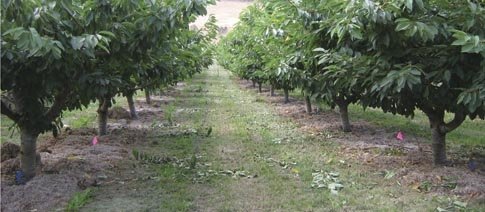
Jennifer Moore-Kucera, research associate at Oregon State University, is collecting data in the two grower trials, comparing soil health below wheat and alfalfa straw mulch placed over the tree rows, with soil health in tree rows kept clean with an herbicide strip. She reported that differences between the two treatments are showing up within the first few years of the research.
Although soil organic matter has not changed within the first two years, she did see changes in biological properties of the soil, Moore-Kucera said. “For example, mulch treatments had increased activity of enzymes involved in nutrient cycling, and there was an increase in the potential of the soil to mineralize organic nitrogen into plant-available forms, through biological activity of different enzymes as well as increased nitrogen,” she said.
Because the straw is not being incorporated into the soil, changes in the soil organic matter are not expected to occur quickly. When material is placed on the soil surface, it usually takes many years to see changes. For this reason, researchers use other, more sensitive tests such as soil enzyme activity to track the effects of management changes on biological functioning in soils.
Mel Omeg, who grows cherries with his son Mike in The Dalles, said they spread about five tons per acre of wheat straw in a test block in August 2005. Their goal was to use the mulch to build-up soil organic matter. At the time, the straw cost $350 to $400 per acre to apply. A bale chopper was used to break up the straw bales before spreading it down the tree row.
“We were hoping the wheat straw would last about three years, but it didn’t,” said Omeg. “The problem with the wheat straw is that it deteriorated within a couple of years.”
In July 2007, they tried again, this time using alfalfa straw. Omeg said that the alfalfa straw seems to have a longer life and is breaking down more slowly than the wheat straw. There is some suppression of weeds from the mulch, however, strip spraying with glyphosate over the mulch is still needed, he said.
While soil biological activity has increased, Omeg said that they are most excited about the water savings.
“We’re seeing that we can reduce water application and use up to 25 percent less water in the straw treatments,” he said, adding that areas of shallow soil in the orchard maintained soil moisture longer than before the straw mulch.
In one site that has varied soil depth and areas with marginal soil quality, he believes that the mulch helped the orchard produce large, firm Sweetheart cherries last year. It yielded five tons per acre at $1.50 per pound.
Omeg said it is too soon to know if the practice is cost effective, but Moore-Kucera told him it is making a statistical difference in soil improvement.
Increasing prices of hay forages made the alfalfa straw application more expensive last year than the initial application made in 2005. Omeg said that it cost about $500 per acre last year for the material and application.
Stacey Cooper, also an orchardist in The Dalles, has observed similar results with straw mulch. They applied wheat straw in fall 2005 to a block of Tieton cherries on Gisela 6 rootstock hoping to improve soil health and saw improvement with just one application.
“The straw is still there and has held up fairly well,” she said. The straw had self-seeded, but they killed it back with glyphosate. A layer of straw was still in place when OSU sampled in 2007.
“We saw results of more nutrient-holding in the soil within a year,” Cooper said.
The mulch practice is “something to think about,” Omeg concluded, adding that they will continue to study the practice with OSU. He believes that in the long term, soil enhancement from the straw will make a difference.

Leave A Comment